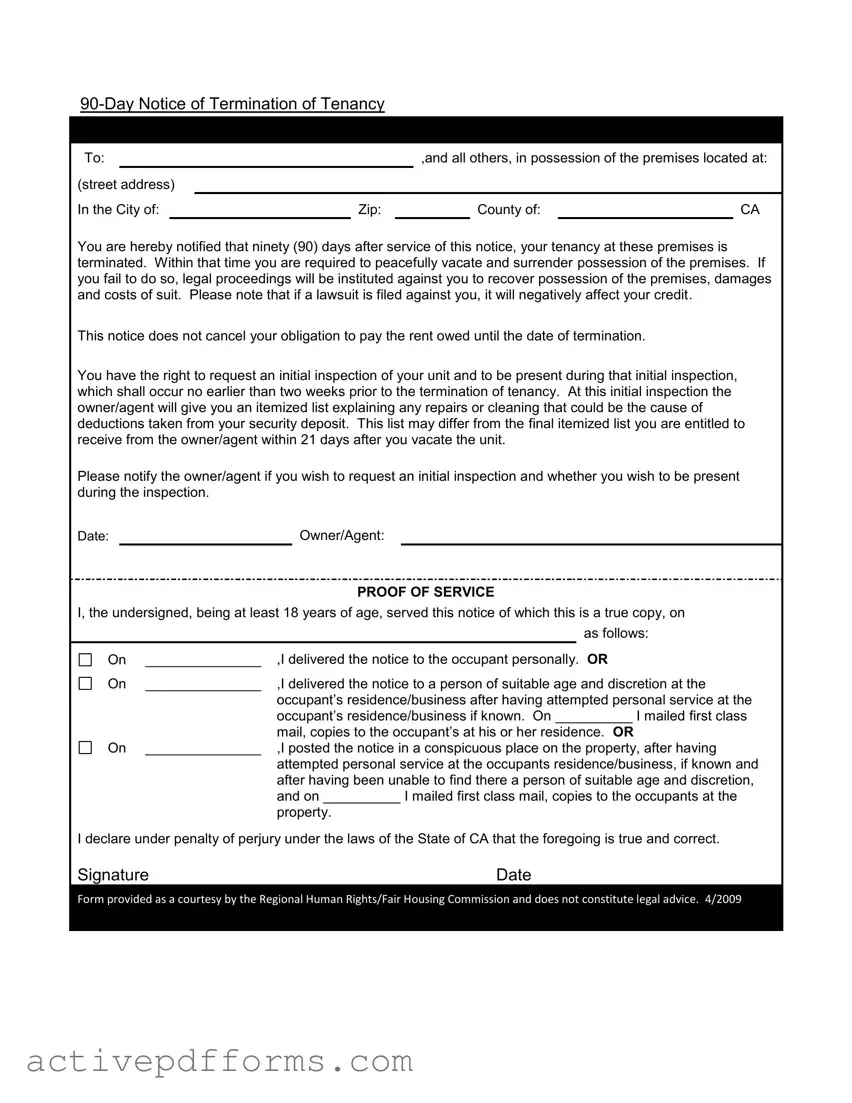90-Day Notice of Termination of Tenancy
|
|
|
|
|
|
|
|
|
|
|
To: |
|
|
|
|
|
,and all others, in possession of the premises located at: |
(street address) |
|
|
|
|
|
|
|
|
In the City of: |
|
|
|
Zip: |
|
|
County of: |
|
CA |
You are hereby notified that ninety (90) days after service of this notice, your tenancy at these premises is terminated. Within that time you are required to peacefully vacate and surrender possession of the premises. If you fail to do so, legal proceedings will be instituted against you to recover possession of the premises, damages and costs of suit. Please note that if a lawsuit is filed against you, it will negatively affect your credit.
This notice does not cancel your obligation to pay the rent owed until the date of termination.
You have the right to request an initial inspection of your unit and to be present during that initial inspection, which shall occur no earlier than two weeks prior to the termination of tenancy. At this initial inspection the owner/agent will give you an itemized list explaining any repairs or cleaning that could be the cause of deductions taken from your security deposit. This list may differ from the final itemized list you are entitled to receive from the owner/agent within 21 days after you vacate the unit.
Please notify the owner/agent if you wish to request an initial inspection and whether you wish to be present during the inspection.
Date:Owner/Agent:
PROOF OF SERVICE
I, the undersigned, being at least 18 years of age, served this notice of which this is a true copy, on
|
|
|
as follows: |
On |
_______________ |
,I delivered the notice to the occupant personally. OR |
On |
_______________ |
,I delivered the notice to a person of suitable age and discretion at the |
|
|
occupant’s residence/business after having attempted personal service at the |
|
|
occupant’s residence/business if known. On __________ I mailed first class |
|
|
mail, copies to the occupant’s at his or her residence. OR |
On |
_______________ |
,I posted the notice in a conspicuous place on the property, after having |
|
|
attempted personal service at the occupants residence/business, if known and |
|
|
after having been unable to find there a person of suitable age and discretion, |
|
|
and on __________ I mailed first class mail, copies to the occupants at the |
|
|
property. |
I declare under penalty of perjury under the laws of the State of CA that the foregoing is true and correct.
Form provided as a courtesy by the Regional Human Rights/Fair Housing Commission and does not constitute legal advice. 4/2009

